It looks like you're using an Ad Blocker.
Please white-list or disable AboveTopSecret.com in your ad-blocking tool.
Thank you.
Some features of ATS will be disabled while you continue to use an ad-blocker.
share:
reply to post by primalfractal
I have some thoughts I'll share tomorrow. In the meantime, this is probably relevant....www.dtic.mil...
I have some thoughts I'll share tomorrow. In the meantime, this is probably relevant....www.dtic.mil...
alienreality
I've watched several documentaries on Morgellons and read a lot from different studies, but surprisingly none of these were even remotely related to any tabloids.. The documentaries you can Google unless you are extremely lazy. Or need it spoon fed.
Are you motivated to learn the truth, or are you carrying water for someone? Looks like the latter.
Just a modicum of research can show a lot about Morgellons not being some psychological affliction.
When I see a few white coats in a big lab showing how these fibers do not burn, it is not hard to believe.. It is what it is.
Ask yourself which is more likely: A: A conspiracy to make people believe Morgellons is a real disease or
B: A conspiracy to hide the affliction from being known as a real disease after the fact that hundreds even thousands are already infected or complaining about it, and asking for government intervention.edit on 6-10-2013 by alienreality because: add
You are going to have to spoon feed me. I want to know what documentary you watched that showed scientists trying and failing to burn fibers recovered from Morgellons sufferers?
I ask for references. You tell me Google.
Just give me a link. I will watch it.
The report I am staring at right now states this:
Fibers or other materials collected from participants' skin were analyzed at AFIP. Submitted materials were photographed, attached to aluminized slides by drying, crushing or by using conducting adhesive tabs (Polysciences Inc., Warrington, PA) and then analyzed by SEM/EDXA and IR
Notice that there was no burning involved. Burning fibers is sometimes used in textile identification, but that was not case here.
Twenty-three fiber or other material specimens were obtained from diverse intact skin sites in 12 case-patients. The materials were largely composed of protein (83%), likely superficial skin or cellulose consistent with cotton fibers (43%), some with evidence of dyes (Figures 7 A–B). Three samples contained other materials alone or in combination, including polyamide (probably nylon); cellulose nitrate containing bismuth (Bi) consistent with nail polish; and polyethylene (possible contaminant from specimen container lid
So they found skin, cotton fibers, dye, and nail polish.
And look, a reference:
www.plosone.org...
Your turn.
reply to post by primalfractal
CNN and doctors at Frigging stoneybrook, one of the greatest teaching hospitals in the world, aren't good enough for him, so don't expend too much energy trying to explain too much, you will always be wrong and none of it is real .
*coughs*
CNN and doctors at Frigging stoneybrook, one of the greatest teaching hospitals in the world, aren't good enough for him, so don't expend too much energy trying to explain too much, you will always be wrong and none of it is real .
*coughs*
edit on 10/7/13 by PtolemyII because: (no reason given)
Not sure if this is helpful to anyone, but here's another research article. I'll put the abstract in my post but the whole paper is here ->
SOURCE
Background Morgellons is a poorly characterized constellation of symptoms, with the primary manifestations involving the skin. We conducted an investigation of this unexplained dermopathy to characterize the clinical and epidemiologic features and explore potential etiologies. Methods A descriptive study was conducted among persons at least 13 years of age and enrolled in Kaiser Permanente Northern California (KPNC) during 2006–2008. A case was defined as the self-reported emergence of fibers or materials from the skin accompanied by skin lesions and/or disturbing skin sensations. We collected detailed epidemiologic data, performed clinical evaluations and geospatial analyses and analyzed materials collected from participants' skin. Results We identified 115 case-patients. The prevalence was 3.65 (95% CI = 2.98, 4.40) cases per 100,000 enrollees. There was no clustering of cases within the 13-county KPNC catchment area (p = .113). Case-patients had a median age of 52 years (range: 17–93) and were primarily female (77%) and Caucasian (77%). Multi-system complaints were common; 70% reported chronic fatigue and 54% rated their overall health as fair or poor with mean Physical Component Scores and Mental Component Scores of 36.63 (SD = 12.9) and 35.45 (SD = 12.89), respectively. Cognitive deficits were detected in 59% of case-patients and 63% had evidence of clinically significant somatic complaints; 50% had drugs detected in hair samples and 78% reported exposure to solvents. Solar elastosis was the most common histopathologic abnormality (51% of biopsies); skin lesions were most consistent with arthropod bites or chronic excoriations. No parasites or mycobacteria were detected. Most materials collected from participants' skin were composed of cellulose, likely of cotton origin. Conclusions This unexplained dermopathy was rare among this population of Northern California residents, but associated with significantly reduced health-related quality of life. No common underlying medical condition or infectious source was identified, similar to more commonly recognized conditions such as delusional infestation.
edit on 7-10-2013 by AlliumIslelily
because: added "external source" tags
reply to post by primalfractal
And you don't see a problem with the line "none of which was collected by biopsy"?
And you don't see a problem with the line "none of which was collected by biopsy"?
reply to post by BanTv
The nanofiber scaffold looks close to the mark, linked to other devices.
Maybe hydrogels are involved.
I was gonna put a couple of videos up with some technical descriptions but my internet wont work. DNS server not responding, phone works through same server but wouldn't load
ATS only, fine on other sites. Its taken all afternoon and evening to get this post done. Weird. Anyway, one of the videos is called "Morgellons is a silent superbug and fibrous disease" on YouTube.
The nanofiber scaffold looks close to the mark, linked to other devices.
Maybe hydrogels are involved.
I was gonna put a couple of videos up with some technical descriptions but my internet wont work. DNS server not responding, phone works through same server but wouldn't load
ATS only, fine on other sites. Its taken all afternoon and evening to get this post done. Weird. Anyway, one of the videos is called "Morgellons is a silent superbug and fibrous disease" on YouTube.
reply to post by primalfractal
Is this the one you wanted? There are several there on the topic.
And this one looks interesting, as well:
Is this the one you wanted? There are several there on the topic.
And this one looks interesting, as well:
edit on 10/7/2013 by sled735 because: add link
last night after reading this thread i googled Morgellons disease for a couple of hours. i found morgellon victim support forums with thousands of
members. i read things about morgellon so bizarre that i got dizzy. photos of weird microscopic "nano devices" that grow inside the wounds of
people. skin tissue that grows numbers and bee-hive textures.people that pull colored fibers out of their bodies and have bugs crawling under their
skin. i read articles from doctors that confirm this things- i saw some videos on youtube where people in laboratories and white suits confirmed this
things. it was just so horrific and fantastic that i thought it was totally unbelievable.
thanks god wikipedia says its a delusion...
i found a website called "morgellons exposed" and a video of a man who claimed to have helped creating the "morgellon". i read that it was created for the military, that it is used on chicken, its in our food,its in the rain, in the chemtrails. its everywhere and everybody is infected.
"ancient aliens" says its alien,its nano-particles , it will grow wires inside us that disrupt our electromagnetic vibration, it will control us and it can be triggered at any time... and it goes on and on and on deep down the rabbit hole.
i got so dizzy i just wanted to find something that debunks this. wikipedia .... is a joke and there is not much convincing debunking going on anywhere.
victim support forums are full of people trying to cure them selfs because doctors wont help. they are marked as crazy. are they ALL imagining stuff ? are all the videos filmed in laboratories and all the photos and analyzes hoaxes ?
i really hope so but sadly i could not convince myself.
what i found hard to find are oficial statements and proof by the scientific community that "Morgellons" does not exist.
thanks god wikipedia says its a delusion...
i found a website called "morgellons exposed" and a video of a man who claimed to have helped creating the "morgellon". i read that it was created for the military, that it is used on chicken, its in our food,its in the rain, in the chemtrails. its everywhere and everybody is infected.
"ancient aliens" says its alien,its nano-particles , it will grow wires inside us that disrupt our electromagnetic vibration, it will control us and it can be triggered at any time... and it goes on and on and on deep down the rabbit hole.
i got so dizzy i just wanted to find something that debunks this. wikipedia .... is a joke and there is not much convincing debunking going on anywhere.
victim support forums are full of people trying to cure them selfs because doctors wont help. they are marked as crazy. are they ALL imagining stuff ? are all the videos filmed in laboratories and all the photos and analyzes hoaxes ?
i really hope so but sadly i could not convince myself.
what i found hard to find are oficial statements and proof by the scientific community that "Morgellons" does not exist.
reply to post by sled735
Thanks heaps, that's the one. Also "morgellons nanotechnology encapsulated bacteria research" is another good one. Ill have a look at the video you posted now.. hopefully.
Thanks heaps, that's the one. Also "morgellons nanotechnology encapsulated bacteria research" is another good one. Ill have a look at the video you posted now.. hopefully.
reply to post by glowdog
Yea, sorry... went down the same rabbit hole a while ago and this was another one of those major shocks that did my head in for a bit. Always these betrayals and horrors heaped upon the people cause grief, to see or to block out.
Hopefully when enough get to the bottom of the damn hole, we can fill it in.
I wish someone had debunked this too.
.
Yea, sorry... went down the same rabbit hole a while ago and this was another one of those major shocks that did my head in for a bit. Always these betrayals and horrors heaped upon the people cause grief, to see or to block out.
Hopefully when enough get to the bottom of the damn hole, we can fill it in.
I wish someone had debunked this too.
.
I've only skimmed this thread but it does seem a little weird...?.
I remember another thread about 'fibres' in McD's chicken (?) nuggets........ If as an earlier post says it was initially in chicken then maybe that's a source..?
www.abovetopsecret.com...
Hmmm......
PDUK
I remember another thread about 'fibres' in McD's chicken (?) nuggets........ If as an earlier post says it was initially in chicken then maybe that's a source..?
www.abovetopsecret.com...
Hmmm......
PDUK
welcome to little weird world.
i´m not convinced that it is a totally imagined disease and that all the material online is just there to sell snake oil. it´s just too many victims.
but i also dont want to accept it is really nano-technology. sure there are many people that debunk this, there must be oficial studies that proof its not nano technology.i probably just couldnt find them. i sure hope so.
getting all itchy with this - and the new emoticons are rubbish btw.
i´m not convinced that it is a totally imagined disease and that all the material online is just there to sell snake oil. it´s just too many victims.
but i also dont want to accept it is really nano-technology. sure there are many people that debunk this, there must be oficial studies that proof its not nano technology.i probably just couldnt find them. i sure hope so.
getting all itchy with this - and the new emoticons are rubbish btw.
edit on 7-10-2013 by glowdog because: had to add a thought
reply to post by PurpleDog UK
Quite possible, I've also heard chemtrails could be the delivery method. Seen the "angel hair" fibers falling from the sky personally, and it definitely wasn't spider webs. There is a recent thread here about it.
Quite possible, I've also heard chemtrails could be the delivery method. Seen the "angel hair" fibers falling from the sky personally, and it definitely wasn't spider webs. There is a recent thread here about it.
reply to post by AlliumIslelily
It is helpful,
Thanks for contributing to the thread
It is helpful,
Thanks for contributing to the thread
edit on 7-10-2013 by primalfractal because: (no reason given)
This is worrisome...
Thank you for sharing this information!
Thank you for sharing this information!
edit on 7-10-2013 by Taz51 because: (no reason given)
OK, here goes...
Re:Morgellons and coloured fibres in the skin.
My son has a small USB digital microscope, which has up to 300x magnification, (you can buy them really cheap in Maplin (uk) and other electronics stores) so I thought that I'd have a bit of a play with it;
If I felt an "itch" or anything... I'd point the scope there and click off a few photos.
I wasn't really expecting to find anything.... especially not embedded blue or red fibres!
But...
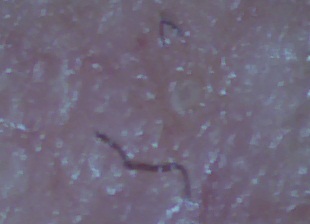
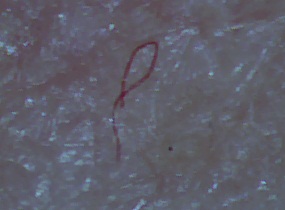
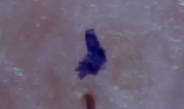
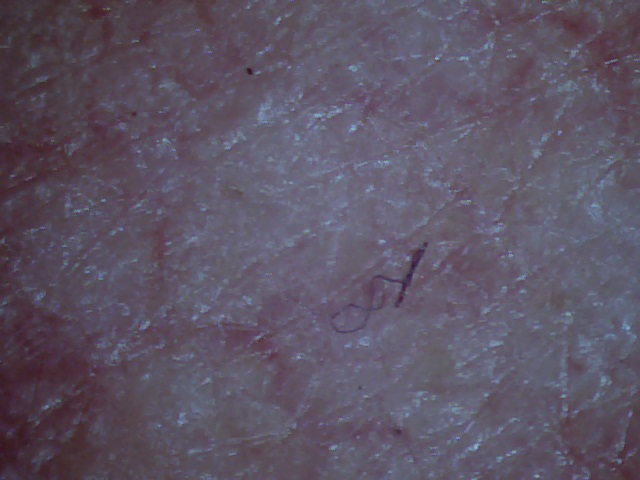
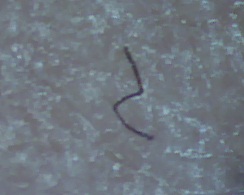
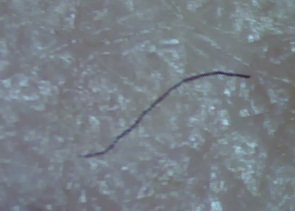
These were all taken at the same magnification, cropped to highlight the "fibres" but I'll include one full image too, for scale so you can see hair stubble for size comparison.
I think that the stubble hairs are about 10x larger than the fibres?
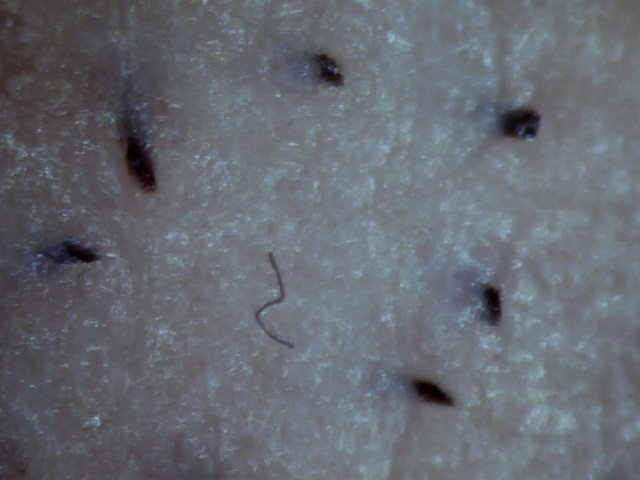
WTF??
I'm guessing that these are just from clothing/textiles etc??? But some of them do look like they're...entering/exiting the skin? it does make you think...
Anyone??
Re:Morgellons and coloured fibres in the skin.
My son has a small USB digital microscope, which has up to 300x magnification, (you can buy them really cheap in Maplin (uk) and other electronics stores) so I thought that I'd have a bit of a play with it;
If I felt an "itch" or anything... I'd point the scope there and click off a few photos.
I wasn't really expecting to find anything.... especially not embedded blue or red fibres!
But...






These were all taken at the same magnification, cropped to highlight the "fibres" but I'll include one full image too, for scale so you can see hair stubble for size comparison.
I think that the stubble hairs are about 10x larger than the fibres?

WTF??
I'm guessing that these are just from clothing/textiles etc??? But some of them do look like they're...entering/exiting the skin? it does make you think...
Anyone??
Apparently some people are still parroting the government's claim that this is not a physical disease, but more of a psychological condition. IF the
government or aspects of the government have something to do with this disease, or know more than they are willing to say, which probably means they
are involved in some manner, then that would explain their tenacious argument and repetition of the psychological explanation. Plus, they know that
many people will buy what they are selling simply because they are the government. Sheeple, if you will. This is just a possibility, not a fact, by
the way.
But I am thoroughly convinced, as are many exceptional scientists, that this is a legitimate disease of some sort. It cannot be classified as a disease, virus, etc. at this point, considering the mechanism of action is still unknown. However, educated guesses suggest that it is likely some type of disease. The fibers alone are the key to explaining what is going on with this condition. I had never heard the possibility of nanotechnology being linked to these fibers before, and that adds a whole new dimension to the entire thing.
But I am thoroughly convinced, as are many exceptional scientists, that this is a legitimate disease of some sort. It cannot be classified as a disease, virus, etc. at this point, considering the mechanism of action is still unknown. However, educated guesses suggest that it is likely some type of disease. The fibers alone are the key to explaining what is going on with this condition. I had never heard the possibility of nanotechnology being linked to these fibers before, and that adds a whole new dimension to the entire thing.
OK, starting to get a bit freaked out now.
I just used the microscope to look at a small wound on my shin (which I had bashed into the metal footpeg of an offroad motorbike at the weekend)
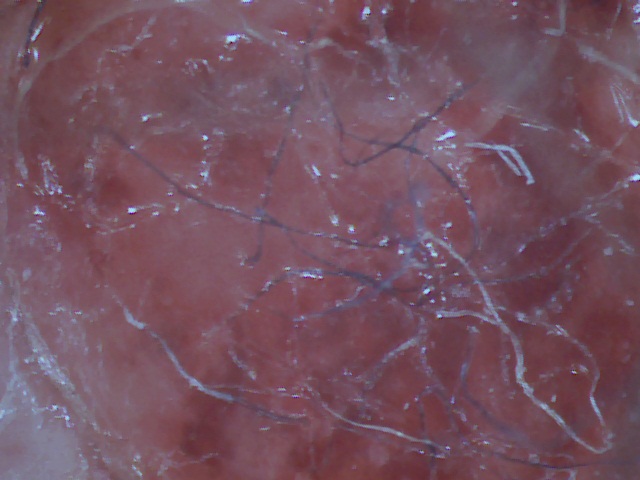
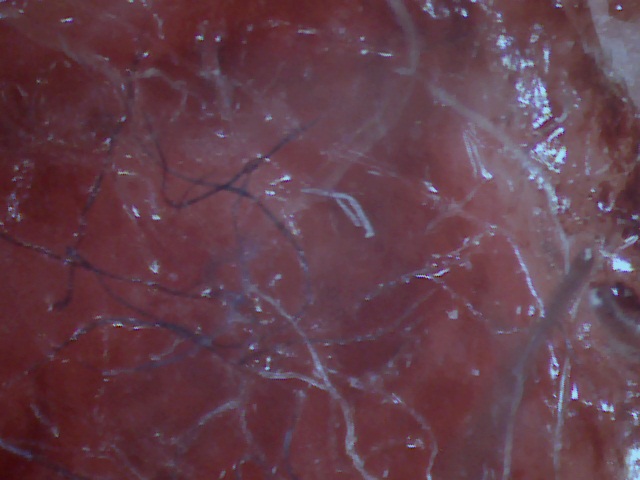
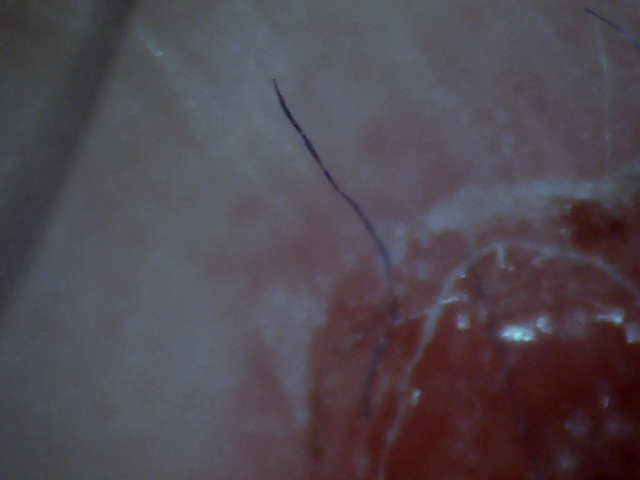
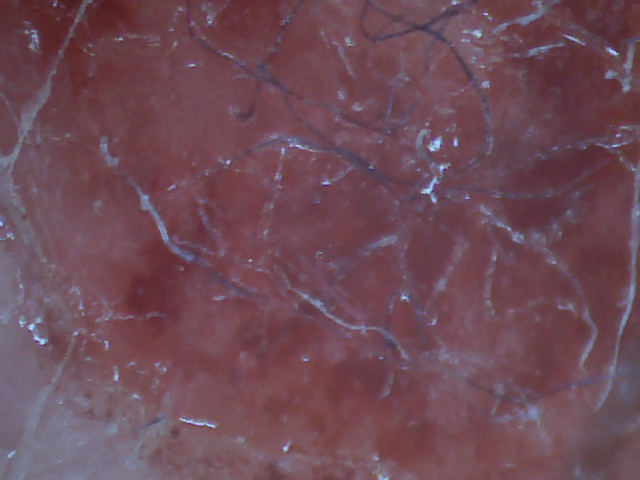
Why are there loads of fibres in there? Some under the surface tissue, some protruding.
Are they from the denim jeans I was wearing at the time?
Here is a pic of my jeans - at the same magnification...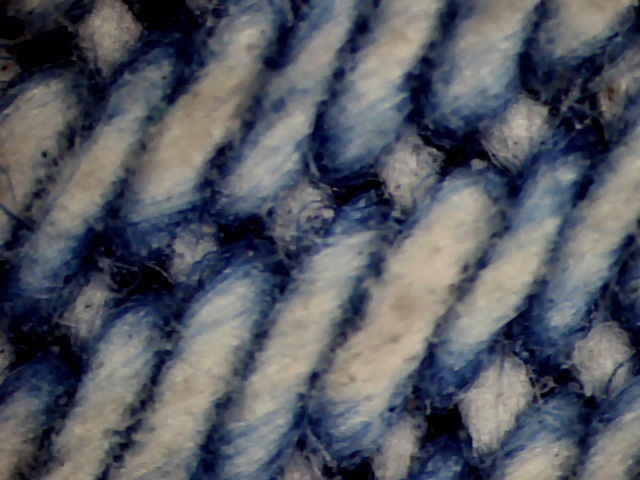
The colours are similar blue/white but I don't see any fibres of the same width as in the wound?
Anyone else got a microscope?? Any Ideas?
GTD
I just used the microscope to look at a small wound on my shin (which I had bashed into the metal footpeg of an offroad motorbike at the weekend)




Why are there loads of fibres in there? Some under the surface tissue, some protruding.
Are they from the denim jeans I was wearing at the time?
Here is a pic of my jeans - at the same magnification...

The colours are similar blue/white but I don't see any fibres of the same width as in the wound?
Anyone else got a microscope?? Any Ideas?
GTD
reply to post by Gordi The Drummer
First, I do believe that Morgellens is a very real disease and I wouldn't be surprised to find that some cases are caused by nano-tech, some are caused by the GMO factors a couple people posted about, and that other cases have other, unknown at present causes...but:
I think in your case, the fibers/threads were rubbing off your jeans into the open wound, then as the wound is healing the new skin is growing around and over the fibers...(The magnification of your jeans is showing 'intact' threads, these break down into the smaller ones in the wound)..
Actually, even unwounded skin could get threads from our clothes in it, because the uppermost layers of skin are in the process of dying, so there will be tiny cracks and crevices where threads from close-fitting clothing are being sort of rubbed 'in' and pushed around under the layers then new skin is forming around the threads...
...but this is a good example of why nano-tech could be very, very, bad for us. I mean, if 'regular' sized cotton fibers can get under skin, just imagine how far into our bodies nano-tech sized fibers (or other stuff) could get...
The scary part - it might not matter whether nano-tech is used for good or bad purposes, the problem is...what will all the nano-particles floating around, polluting our environment, do to us?
Everything made with nano-tech will break up over time, just like tires wear down, or bluejeans shed stray threads (and contribute to dryer fluff), so when I say "floating around", I mean that anything made on the nano scale will eventually become part of the air we breath...
Sorry, back on topic, I feel pretty confidant that you don't have Morgellens ;-)
First, I do believe that Morgellens is a very real disease and I wouldn't be surprised to find that some cases are caused by nano-tech, some are caused by the GMO factors a couple people posted about, and that other cases have other, unknown at present causes...but:
I think in your case, the fibers/threads were rubbing off your jeans into the open wound, then as the wound is healing the new skin is growing around and over the fibers...(The magnification of your jeans is showing 'intact' threads, these break down into the smaller ones in the wound)..
Actually, even unwounded skin could get threads from our clothes in it, because the uppermost layers of skin are in the process of dying, so there will be tiny cracks and crevices where threads from close-fitting clothing are being sort of rubbed 'in' and pushed around under the layers then new skin is forming around the threads...
...but this is a good example of why nano-tech could be very, very, bad for us. I mean, if 'regular' sized cotton fibers can get under skin, just imagine how far into our bodies nano-tech sized fibers (or other stuff) could get...
The scary part - it might not matter whether nano-tech is used for good or bad purposes, the problem is...what will all the nano-particles floating around, polluting our environment, do to us?
Everything made with nano-tech will break up over time, just like tires wear down, or bluejeans shed stray threads (and contribute to dryer fluff), so when I say "floating around", I mean that anything made on the nano scale will eventually become part of the air we breath...
Sorry, back on topic, I feel pretty confidant that you don't have Morgellens ;-)
edit on 7-10-2013 by lostgirl because: (no reason
given)
new topics
-
Fire insurance in LA withdrawn months ago
General Conspiracies: 2 hours ago -
Bizarre Labour Party Tic Toc Video Becomes Even More Embarrassing
Regional Politics: 10 hours ago
top topics
-
The elephant in the room (wearing a hoodie)
US Political Madness: 17 hours ago, 15 flags -
Dr. Demento
Music: 17 hours ago, 6 flags -
Fire insurance in LA withdrawn months ago
General Conspiracies: 2 hours ago, 6 flags -
Bizarre Labour Party Tic Toc Video Becomes Even More Embarrassing
Regional Politics: 10 hours ago, 4 flags -
Potter to WHU
World Sports: 16 hours ago, 2 flags
active topics
-
Los Angeles brush fires latest: 2 blazes threaten structures, prompt evacuations
Mainstream News • 289 • : BeyondKnowledge3 -
Fire insurance in LA withdrawn months ago
General Conspiracies • 11 • : WeMustCare -
The elephant in the room (wearing a hoodie)
US Political Madness • 27 • : Euronymous2625 -
-@TH3WH17ERABB17- -Q- ---TIME TO SHOW THE WORLD--- -Part- --44--
Dissecting Disinformation • 3980 • : AianawaQ1320 -
Judge rules president-elect Donald Trump must be sentenced in 'hush money' trial
US Political Madness • 84 • : Vermilion -
S.C. Jack Smith's Final Report Says Trump Leads a Major Conspiratorial Criminal Organization!.
Political Conspiracies • 47 • : Vermilion -
Statements of Intent from Incoming Trump Administration Members - 2025 to 2029.
2024 Elections • 61 • : cherokeetroy -
Gravitic Propulsion--What IF the US and China Really Have it?
General Conspiracies • 39 • : budbayview -
Its Looking Like Schiff - Vindman - Ciaramella Conspired to Impeach President Trump.
Political Conspiracies • 188 • : WeMustCare -
Trump's idea to make Canada the 51st US state: 'Potential is massive'
Mainstream News • 155 • : DaydreamerX
